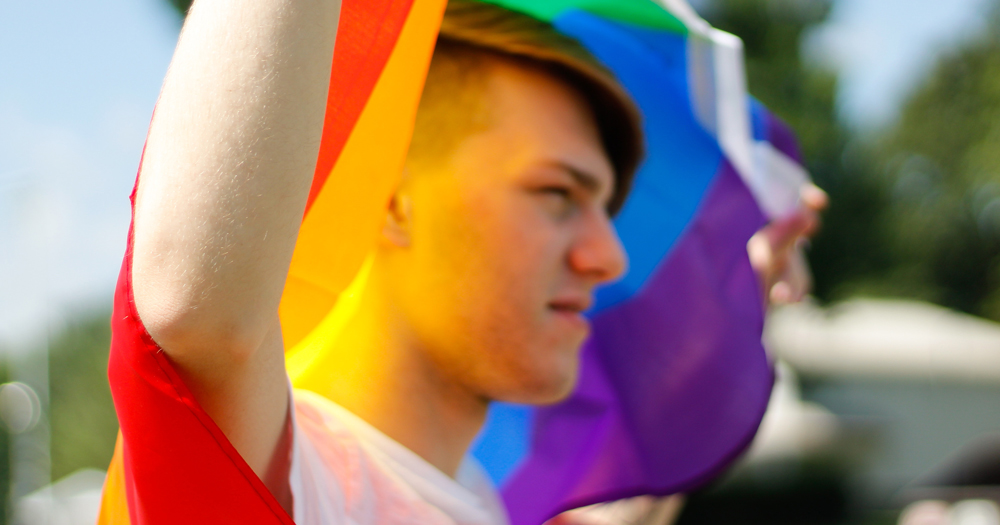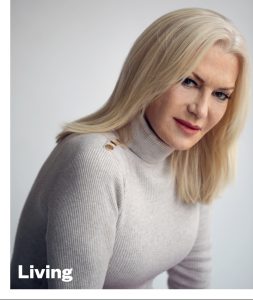Whether I was watching Heath Ledger press his face into Jake Gyllenhaal’s denim shirt at the end of Brokeback Mountain or else listening to the cast of Rent sing a requiem after Angel’s death, I’d grown accustomed to associating my own queer experience with pain and with loss and a lack of joy.
When I was young, I remember sneaking down to the living room in the middle of the night to watch the movies and television shows with queer characters that I didn’t feel safe watching in broad daylight. Those nights, alone on my couch in the blue glow of the television screen, I first realised that the campy threat of ‘conversion therapy’ I’d seen in But I’m A Cheerleader was a real possibility for my future.
I knew I was gay by the time I was ten, though I wouldn’t come out until I was 20. And so, as my own secret burrowed its way deeper into the shadows of my being, I watched on as character after character died from an AIDS-related illness, or else was murdered in a vicious hate crime. Sometimes the suffering was less graphic – sometimes the queer love and joy that had blossomed on screen, however briefly, managed to wither by the time the credits rolled. The couples never ended up together, instead some semblance of happiness in these films was salvaged out of the broken pieces of true joy that had been shattered. It was a consolation prize. I became convinced that my own happiness as a gay man would only come at the cost of some great suffering.
These films, of course, weren’t all doom and gloom – they introduced me to the concepts of liberation, self-discovery, and the value of found family, but too often it was at the cost of the life, liberty, and happiness of one or more LGBTQ+ characters.
Queerness was being associated with grief and suffering everywhere I looked. In the songs and ballads of Hedwig and the Angry Inch, on the Yorkshire fields of God’s Own Country, and in the pages of Ocean Vuong’s On Earth We’re Briefly Gorgeous and Hanya Yanigahara’s A Little Life.
This is, in part, to be expected. Indeed, much of queer history is rife with pain and suffering, even today the LGBTQ+ community faces persecution at every turn, and so to understand one’s queerness through the lens of pain and oppression is entirely valid. For example, I see the HIV and AIDS crisis – which gave us creations like Rent and Pose, and the institution of ‘conversion therapy’ – the catalyst behind films like The Miseducation of Cameron Post – as two of the greatest attributers to the canon of queer suffering as we see it in film, television, and literature.
Both the HIV and AIDS crisis and conversion therapy are very real battles that the LGBTQ+ community have fought, and continue to fight to this day. At the end of 2020, 26 million people were accessing antiretroviral treatment for HIV globally. Additionally, the battle against conversion therapy is still being debated around the world as I write this. As such, it isn’t exactly surprising that much of queer media revolves around these two very prevalent issues facing the LGBTQ+ community.
However, as we move into a world where HIV and AIDS can be monitored and controlled using preventative medications, where Undetectable = Untransmittable is coming to the fore in conversations about HIV, where conversion therapy is being banned little by little, queer media does not seem to be getting any happier.
Call Me By Your Name manages to end in despair for Elio without either of these tragedies influencing his story. Madeline Miller’s Song of Achilles, a re-telling of Homer’s The Odyssey, exists outside of the temporality of HIV and conversion therapy, but still kills off both of the queer male love interests, making for an altogether heartbreaking read. While Miller’s novel is a re-telling and therefore owes some modicum of accuracy to the source material, the novel’s explicit queerness cannot exist outside of contemporary depictions of queer despair.
Part of the question, then, is why? Why is queer media so often diffused through grief? To put it simply, it’s because more often than not, the life of a queer person starts out mired in homophobic and transphobic rhetoric. Queer happiness and joy is something that, oftentimes, can only come to fruition in adulthood when access to a chosen community is available.
TJ Klune, the author of The House by the Cerulean Sea has called for the introduction of more positive (joyful, happy) queer media. In an interview with Broad Recognition, Klune described “queer joy” as “a celebration of all the things that I didn’t get growing up and that so many others didn’t get growing up. Because we didn’t know if we would have a happy ending.”
In Klune’s novel, Linus Baker finds unlikely love with Arthur Parnassus, the owner of an orphanage he is visiting as a case worker on behalf of the children housed there. Linus and Arthur’s story is not all sunshine and lemon drops from start to finish, they deal with problems, with their own trauma even, but they are awarded the happy ending that has remained elusive for queer characters such as themselves.
Klune describes being tired of the tragedy that has befallen most of queer media throughout his life. “The more I saw queer people in media, we were either there to be the stereotypical flamboyant sidekick, to teach a lesson to the straight characters, or we got sick or we were beaten [and] killed,” Klune added.
When asked how he set out to work against dismantling a queer narrative that had become so closely intertwined with sadness and grief Klune had this to say: “When I started writing, I knew that no matter what happened in the book, no matter how rocky the road would be, the queer characters would get happy endings. Because that’s what we deserve. Hell, I’ll even go so far as to say that’s what we’re owed. We are owed our happy endings because if we don’t create them for ourselves, nobody’s gonna give them to us.”
Showrunners and authors alike have pushed back against the sentiment that LGBTQ+ characters ought not to be killed off. They suggest that anyone can and should be killed off, and that for LGBTQ+ viewers to expect some sort of immunity for queer characters is an unreasonable expectation.
However, when queer characters are disproportionately underrepresented in media, their deaths often mean more to viewers because the stakes are much higher. If a show only has one Trans character, for instance, then when that character is killed off (likely because they are Trans), Trans viewers no longer have anyone to relate to on a personal level. Whereas straight viewers will always have a plethora of characters to choose from even if their favourite straight character is killed off. Showrunners and screenwriters often manipulate queer audiences by dangling the lives of queer characters in front of us only to let them fall to their deaths in aid of some episode-long attempt at pandering.
GLAAD director of entertainment research and analysis, Megan Townsend, said in an interview with Marie Claire that ”Since the beginning of 2015, we’ve lost more than 50 queer women on television -often in violent ways that benefit somebody else’s story.”
Townsend’s statement only echoes Klune’s point that, even in death, queer characters only lasting effect in media is their role in the journey of the straight hero.
VE Schwab, the author of The Invisible Life of Addie LaRue, is not against killing off queer characters, however. Schwab, a queer woman herself, said in a 2019 Tweet that the problem isn’t simply that the woman dies. It’s that “her sole merit in the narrative is the way in which that death affects the male character”.
Schwab, unlike Klune, calls for queer deaths, and character deaths in general, that mean something for the queer characters themselves, that provide a satisfying and meaningful arc to the character’s story that is something more than a motivation for another (likely straight) character.
It is perhaps impossible to say which of these methods of approaching queer joy in media is the most appropriate route to producing content that is not only positive, but truthful to the queer experience at large.
Likely these trends and patterns won’t change until more queer writers, producers, and showrunners are at the helm of these projects. While more and more queer characters flood our screens in what sometimes feels like a consolation prize of its own, some ‘ticking of the boxes’ for representation, I wonder when, if ever, queer characters will be able to live their truth on screen without the threat of being killed off for the sake of yet another straight hero.
This article on Queer Joy originally appeared in GCN Issue 369 which you can read in full here.
© 2021 GCN (Gay Community News). All rights reserved.
This article was published in the print edition Issue No. 369 (December 3, 2021). Click here to read it now.
Support GCN
GCN is a free, vital resource for Ireland’s LGBTQ+ community since 1988.
GCN is a trading name of National LGBT Federation CLG, a registered charity - Charity Number: 20034580.
GCN relies on the generous support of the community and allies to sustain the crucial work that we do. Producing GCN is costly, and, in an industry which has been hugely impacted by rising costs, we need your support to help sustain and grow this vital resource.
Supporting GCN for as little as €1.99 per month will help us continue our work as Ireland’s free, independent LGBTQ+ media.

